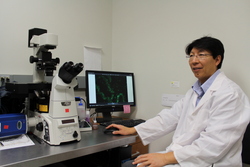
One of 11 “death-by-cancer” genes, named so for their association with severe tumor progression, the chain of events sparked by ubiquitin-specific peptidase 22 (USP22) has been revealed for the first time.
What Deyu Fang, PhD, associate professor in pathology, uncovered, is the way in which USP22, a recently identified cancer stem cell gene, interacts with and stabilizes the enzyme SIRT1.
As SIRT1 strengthens, it causes a reduction of the tumor-suppressing protein 53 (P53). With lower levels of P53, cancers are able to develop more aggressively. The chain of events, published in Molecular Cell, provides new knowledge into how USP22 functions in the development of colorectal and ovarian cancer, and may someday lead to better methods of therapeutically targeting the gene.
“Despite the successful surgical removal of solid tumors and chemo- or radiotherapy, a significant number of cancer patients show a recurrence and metastasis of the disease,” Fang said. “These recurrences are due to a small number of drug resistant cells that survive the treatment. The molecular mechanisms underlying how these cancer stem cells are developed and grow remains a biopathological mystery.”

However, new findings from the Fang laboratory shed light on the subject. Researchers concluded that USP22 is highly expressed in human colon cancer stem cells in which the function of p53 is largely suppressed. This elevated USP22 activity results in an increase in cancer cells.
In pursuit of cancer-fighting options, Fang is working to develop inhibitors that might also kill the treatment-resistant stem cells.
“Based on the structure of USP22, we were able to design a small chemical to mimic the scaffold. From there we found a couple of molecules that can specifically inhibit the gene,” Fang said. “Now we are experimenting using culture dishes and mice models to see if the inhibitor can induce the death of colon cancer cells, in particular the cancer stem cells.”
His lab is currently using both genetic and pharmacological approaches to study the therapeutic efficacy of USP22 suppression in cancer treatment.






